Adapting Dairy Farm Systems
Project Background
The Adapting Dairy Farm Systems project began in 2019 and aims to provide dairy farmers with information and resources to support them to make well-informed decisions when considering new feeding and housing systems.
The Australian dairy industry is currently in a state of unprecedented and rapid transformation, with numerous dairy businesses in northern and southwest Victoria, inland New South Wales, Queensland and South Australia making changes in the production system to address evolving feedbase and climatic pressures.
Without targeted and strategic support to facilitate farming system adjustment, there is significant risk parts of the dairy industry may not transition quickly enough, and farmers could make poor investment decisions.
This program has formed collaborative partnerships with Agriculture Victoria, Murray Dairy, NSW DPI and subject matter experts both within and outside of Australia. A National Feeding System Strategy Advisory Committee (a community within dairy Moving Forward) has also been established to serve as a consultative group for work around feeding and housed systems Research, Development and Extension (RD&E) priorities and provide constructive technical and strategic advice in this area.
Project Objective
The objective of the Adapting Dairy Farm Systems program is to provide Australian dairy farmers with information and resources that will support them to make well informed decisions when designing and using cattle feeding and housing systems, to ensure profitability is maximised and risks are minimised. Specifically, the program will:
- Provide farmers (and their advisers) access to robust and evidence-based information to support their decision making as they contemplate change in the areas of feedbase alternatives, cattle feeding infrastructure and housing infrastructure.
- Provide farmers access to a decision support process that will identify and mitigate risks before any capital is invested and farm systems changes are enacted. This decision support process may also be used to optimise infrastructure management post investment.
- Provide farmers with access to Australian based service providers with recognised expertise and skills in the areas of intensive farming systems or cattle housing design.
- Provide industry recognition and support for the farmers currently using or intending to move their businesses towards forms of intensive feeding system and/or housing system.
Project Activities
Adapting Dairy Farm System program areas of research, development and extension:
-
Economic and risk analysis of intensive feed systems
The project aims to provide economic and risk analysis for intensive feed systems in the dairy industry. It is funded by Dairy Australia, Agriculture Victoria, NSW DPI, and DairyUP. The goal is to assist farmers in making informed decisions when transitioning to new feeding and housing systems.
Dairy feed production systems vary based on the proportion of pasture and supplementary feed in the diet, and these choices are influenced by farm managers' goals, available resources, and the adoption of new technology and management practices.
Due to factors like irrigation water availability, water price, pasture growth variability, and persistence, dairy farm systems are shifting towards more complex combinations of feedbase, feed delivery, and herd management, including cattle housing systems.
The economic aspect of the project involves using farm data to validate assumptions about feeding a total mixed ration (TMR) and understand the factors contributing to the profitability of the new system. The data from selected TMR farms in different states will be aggregated and used to create a framework to support dairy farmers undergoing or considering a feeding system change. -
Technical review alternate feedbase, forage options and herd management infrastructure
This review, authored by Ray King and Steve Little assessed published material, primarily from Australia, on feedbase options for dairy systems other than pasture. It also reviewed Australian and overseas information on feeding and herd management infrastructure. -
National Guidelines for Dairy Feedpads and Contained Housing Systems
The second edition of the National Guidelines for Dairy Feedpads and Contained Housing has been developed collaboratively in partnership with Agriculture Victoria. The guidelines are the first of their kind anywhere in the world and are an invaluable resource for farmers across all Australian dairy regions when making decisions around feeding and housing solutions for their herds.
They are based on global best practice, underpinned by published research and engineering standards, and reflective of current Australian statutory and regulatory planning.
The guidelines were written by a team of 21 subject matter experts from around Australia and the world.
Download the National Guidelines for Dairy Feedpads and Contained Housing. -
Farm System Evaluator
-
Adapting Farm Systems overview
PDF, 542.49 KB
Farm System Evaluator is an online tool that enables farm business performance to be assessed across key management areas. The tool uncovers the benefits and limitations of operating a new feeding and housing infrastructure that may suit specific on-farm needs. It also develops a strategic action plan to help farmers visualise a proposed feeding and housing infrastructure change.
Contact Karen Romano, if you have any feedback or suggestions about the tool.
-
-
Further Project Deliverables
Find out more about key project deliverables here
-
Adapting Farm Systems overview
PDF, 542.49 KB
-
Feeding & Housing System Descriptions
Due to a combination of mitigating factors such as constraints around irrigation water availability and pricing, pasture persistence, varying climatic events, higher production cows, better feeding efficiencies there is a shift in some dairy farm systems towards more complex combinations of feedbase, feed delivery and herd management including cattle housing systems.
Good infrastructure investment relies on sound analysis of your available options. Descriptions of off-paddock facilities:
-
Permanent Feedpad: (Estimated Cost < $1,500 / Cow)
A permanent feedpad is a specifically designed area with a hard surface used to feed out a partial mixed ration (PMR) for daily supplementary feeding of cows on a regular ongoing basis supporting grazing. These permanent facilities are usually slopped to accommodate various cleaning systems to support cleaning and are designed for adequate cow spacing.
This infrastructure is classified as a point source facility, which requires an appropriately designed effluent system and management strategies as cattle may occupy the facility
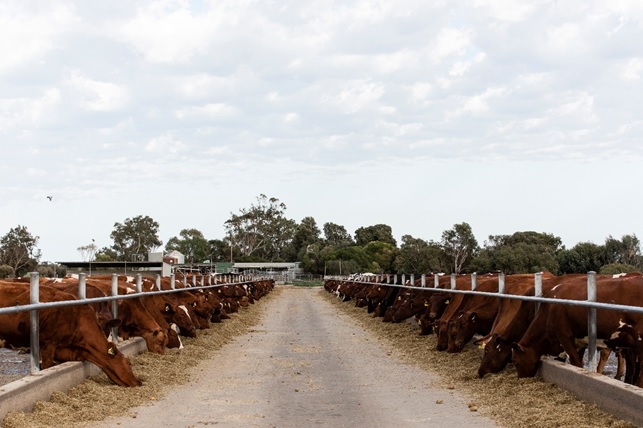
A typical progression is the incorporation of a roof structure over the concreted sloped pad and extended eaves for cow loafing– usually a starting point to transitioning from grazing/PMR to TMR.
-
Dairy Dry Lot: (Estimated Cost $1,500 - 2,500 / Cow)
Earthen compacted and sloped pens including stand-alone cattle shelters and direct access to a permanent feedpad. Rainfall is captured of the shelter roofing and directed to drainage to minimise wetting around the infrastructure. Animals fed a TMR.
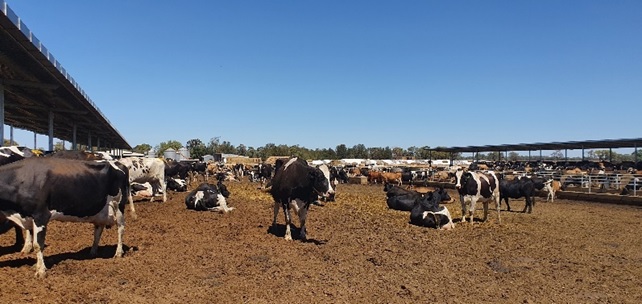
-
Barn - Loose Housing: (Estimated Cost $2,500 - 5,000 / Cow)
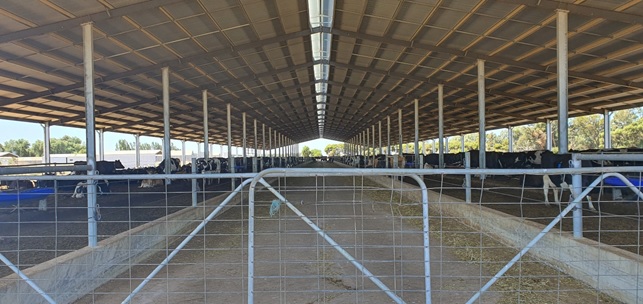
Compost bedded pack is an alternative loose floor system or approach for dairy housing facilities that is typically suited to warmer and dryer climates. The set up often utilises centralised cow alleys and feed alleys, and in this respect the layout can be similar to freestall facilities. A key difference is the bedded pack area replaces individual stalls.
To perform well adequate bedding material (wood chip or sawdust), cow spacing and ventilation are critical. The bedded pack requires aeration twice a day to refresh the surface and enhance microbial activity in the pack.Appropriate ventilation (air exchange) is needed to remove cow heat and moisture, as well as the heat and moisture that the biologically active pack generates. Compost pack housing generally have an overhanging eave to minimize roof runoff and rain from being blown in onto the bedded pack.
The concept of this system is that it provides a loose housing environment where the animals have a larger, open resting area and a softer lying surface. Simultaneously, the system follows an intensively managed compost process. These systems may accommodate longer term occupation of the herd, depending on spacing allowances, and provide flexibility manage the calving process and cows requiring treatment.
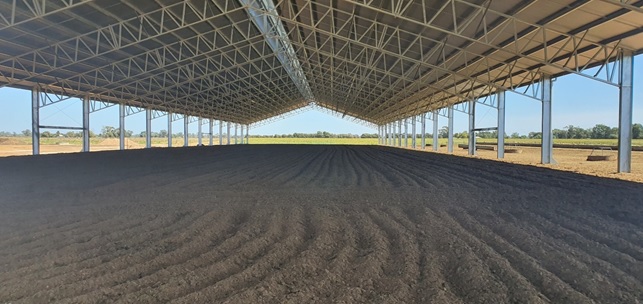
-
Freestall: (Estimated Cost > $5,000 / Cow)
Permanent engineered structures in which dairy cattle are housed and offered a TMR. They may be open air, partially or fully enclosed. Typically, they are constructed with a centralised feed alley supported by cow alleys either side allowing cows to access individual bedding stalls (freestalls) where cows can lie down or feed depending on their need.
Cow alleys are flood washed/scraped several times each day to remove manure to a professionally designed effluent system. Freestall bedding areas are cleaned daily to maintain cow comfort, health and production performance.
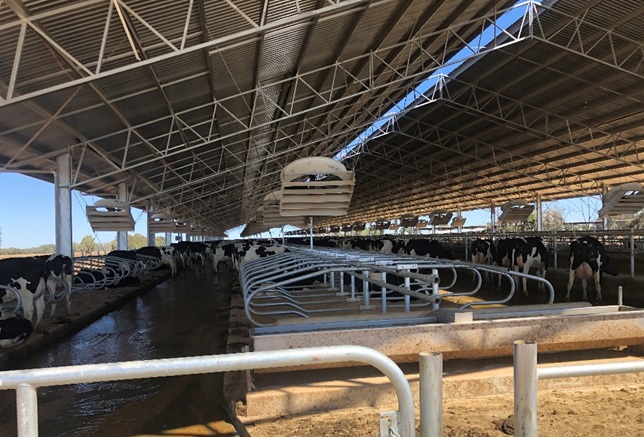
Feeding and Housing System Case Studies
The Australian dairy industry is undergoing significant transition as businesses adapt to reduced water availability, a changing climate, higher input costs, policy and market drivers. In some regions a steady change in the dairy feedbase has occurred, with increased annual pastures, cropping and fodder conservation, and an evolution to partial and total mixed rations.
The future operating environment is likely to be characterised by increasing variability and volatility, requiring adaptive management at all levels. Farm businesses are taking different approaches to managing these changes based on a range of factors related to the business and to the people behind it.
The following case studies are focussed on system change occurring across various regions in Australia. These are not intended to be a blueprint for change, rather to provide examples of the different strategies that businesses are using to manage risk and volatility in the current environment.
Feeding Equipment & Feeding Infrastructure
-
Purchasing a mixer wagon
AT A GLANCE:
- Scott & Anna Fitzgerald | Tongala, Victoria
- 460 cows | 108 ha
- Purchasing a mixer wagon
- PMR transitioning to TMR
- Summary
With an increase in cow numbers and changes in water availability, the Fitzgeralds have considered alternative options for their feedbase. The Fitzgeralds purchased a 50 ha outblock in 2018 and installed a 28 ha centre pivot and planned to grow fodder. However, as water price and water availability became less reliable and the cows were being 100 per cent hand fed they needed to review their feeding infrastructure. This case study follows the transition of their business from feeding maize silage and vetch hay, to building a gravel feedpad and purchasing a mixer wagon.
-
Building a concrete feed pad
AT A GLANCE:
- Colin, Karen, Chris & Ashleigh Gamble | Bamawm, Victoria
- 400 cows
- Building a concrete feed pad
- PMR, cattle graze pasture & crops
- Summary
The Gamble Family have traditionally run a perennial pasture-based system on their dairy farm. With the escalation in water and feed prices in 2015, the Gambles first leased a mixer wagon in November 2015 and then purchased their own 3 months later. Seeing the results from the introduction of the mixer wagon the Gambles decided to make a system change and have since constructed a concrete fed pad to accommodate 400 cows with loafing areas. This case study describes their system change.
-
Building a Concrete Feed Pad Case Study
PDF, 2.21 MB
-
Basic feed-out area
AT A GLANCE:
- Mark, Ann & Jacob Gardiner | Bamawm, Victoria
- 900 cows | 300 ha
- Purchasing a mixer wagon & concrete troughs
- PMR, cattle graze pasture & crops
- Summary
The Gardiner Family have traditionally managed a highly profitable grazing system with perennial ryegrass the major component of the feedbase supplemented with concentrates and silage or hay. Tighter seasonal allocations of water and rising water prices in 2019-20 season ruled out irrigating perennial ryegrass over summer compared to purchasing in forages leading the Gardiners to think about a system change to mitigate the current operating environment. Importantly, this change needed to allow them to switch back to a perennial pasture-based system again when water prices make it economical.
Housing infrastructure
-
Clear Roofed Compost Shelter
AT A GLANCE:
- Simon Rea | Naringal, Victoria
- 560 cows | 225 ha + 100 ha support area
- Clear roofed compost shelter
- Summary
The Rea's built the clear roofed compost shelter to help shelter cows during winter and protect pastures from damage during wet conditions. It also helps to keep cows cooler during the summer. Learn more about the cost of construction, shelter management and operation and benefits to their farming system.
-
Clear Roofed Compost Shelter Case Study
PDF, 464.46 KB
-
Double sided Compost Barn
AT A GLANCE:
- Ray Smith | Yarrimbah, NSW
- 750 cows | 4,000 ha wheat/canola cropping & dairy farm
- Double sided compost barn
- PMR, cattle graze pasture & crops
- Summary
The Smith's supply milk all year round with their herd averaging 10,000 litres/cow/year. The shelter was built to improve cow comfort and cow health both in summer and winter. The cows graze most of the year and utilise the barn at night time. The barn allows better maintenance of winter pasture and improves pasture utilisation.
-
Double sided Compost Barb Case Study
PDF, 540.74 KB
-
Double Compost Barns with open central Feed Land
AT A GLANCE:
- The Bourke Family Farm | Gladfield, Queensland
- 560 cows | 486 ha + 100 ha support area
- Double compost barns
- PMR in winter & TMR in summer
- Summary
The Bourke family supply milk all year round milking twice-a-day. They grow their own feed including corn, barley and ryegrass silage and hay. The compost barns were built mainly to allow easy management of cows during wet weather as well as for cows cooling during hot weather. Since building the barns cow management is easier and milk production is more stable.
-
Double Compost Barns with Open Central Feed Land Case Study
PDF, 422.14 KB
-
Narrow Compost Shelter with Feedpad
AT A GLANCE:
- The Garratt Family Farm | Southbrook, Queensland
- 230 cows | 535 (245 ha cropping country, balance bush)
- Narrow compost shelter with feedpad, open feed bunk and dry lot
- PMR in winter & TMR in summer
- Summary
The Garratt family supply milk all year round and grow all their own feed, making silage from forage sorghum and barley as it is too dry to reliably grow corn. Due to herd growth, the feeding system has changed to less grazing and more time on the feed pad accessing a TMR. This has added to cow management issues, especially herd health, heat stress and wet weather management. Building a roof over the feedpad and later expanding the roof to incorporate compost bedding loafing area solved the herd health issue and minimised exposure to weather.
-
Narrow Compost Shetler with Feedpad Case Study
PDF, 509.77 KB
-
Information Sheet: Budding pack shelters
AT A GLANCE:
- By Dr Philip Chamberlain | Subtropical Dairy
- Bedding Pack Shelters (including compost bedding packs)
- Summary
This information was collected from twelve dairy farmers in Queensland, Southern NSW and Victoria, who have built, and are now managing bedding pack systems. A review of literature has been conducted and highlighted information mainly from USA, Britain, Holland and Israel, much of which is relevant to Australian conditions. This is not a scientific paper, this document summarises Australian farmers' experiences as well as their issues, limitations and management requirements.
-
Bedding Pack Shelters Case Study
PDF, 10.78 MB
Drylots
-
Semi Compost Shelters in Drylots
-
Semi Compost Shelters In Drylots Case Study
PDF, 417.26 KB
AT A GLANCE:
- Rachael Parkes & Ged Mullins | Ellangowan, Queensland
- 1,000 cows | 1,040 ha (800 ha leased)
- Dry lot with roofed shelters
- TMR, mostly from contract purchased feed
- Summary
Rachael and Ged run a mixed breed commercial herd which are fed a TMR. They use drylots with roofed shelters for the milking herd to mitigate heat stress in summer, provide better cow comfort and gain a subsequent increase in cow health and production. This system works well in their relatively dry environment and are working towards have all classes of stock housed on dry lots with roofed shelters in the future.
-
-
Barn with open outside Feed Alley and Drylots
-
Barn with open outside Feed Alley And Drylots Case Study
PDF, 371.66 KB
AT A GLANCE:
- The Scheuerle Family Farm | Kulpi, Queensland
- 300 cows |
- Barn & dry lot
- TMR
- Summary
The Scheuerle family farm feed a TMR based on sorghum silage and winter crop hay. Shelter was built to shelter the herd from heat in summer and occasional extreme wet conditions and to provide better cow comfort and cow health.
-
-
Operating an Intensive Farm System Drylots
AT A GLANCE:
- David & Robyn Kuck | Tongala, Victoria
- 450 cows | 980 ha (includes 274 ha leased land) | No irrigation
- Operating an intensive farm system - drylot
- TMR
- Summary
The Kuck's run a TMR system. They purchase grain and by-products when the opportunity is favourable. They aim to grow all the fodder required however, will purchase silage/ha if a good opportunity arises. The focus of their fodder production is to generate a large quantity of silage and then balance the ration with the grain and by-products. They predominately grow sorghum as it is difficult to grow high quality pastures in their region without irrigation. In this case study the Kuck's share several take home messages and offer advice to new entrants considering this type of system.
-
Operating an Intensive Farm System – DRYLOT Case Study
PDF, 245.49 KB
